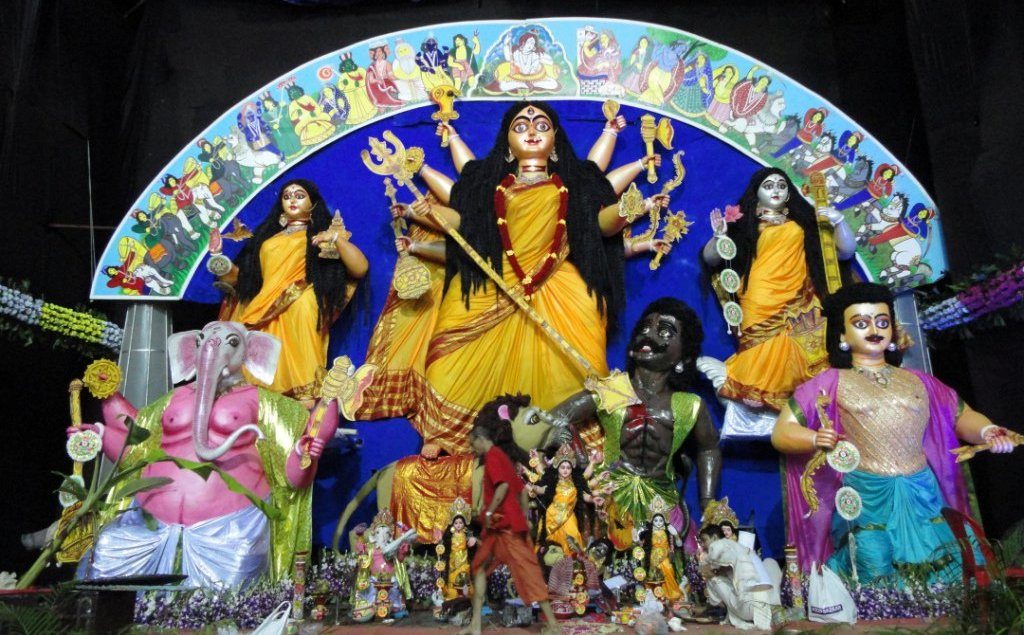
The most popular festival in the Indian state of West Bengal, Durga Puja, also called Durgotsav, is an annual Hindu festival during which devotees revere Goddess Durga. This festival marks the epic battle, and victory, of Goddess Durga over the powerful buffalo demon, Mahishasura. The festival is celebrated to epitomise the victory of good over evil.

Durga Puja, also known by its many traditional names like Akalbodhan, Sharadiya Pujo, Sharadotsav, Maha Pujo, Maayer Pujo, and Durga Pujo, is observed in the month of Ashvin, according to the Hindu Lunar calendar. Following the Gregorian calendar, the festival falls in the months of September or October.
The festival of Durga Puja is also popular in states like Assam, Tripura, Odisha, Bangladesh and Nepal, where it is locally called Dashain.
The festival dates coincide with Vijayadashami (or commonly known as Dussehra). On Dussehra, the victory of Lord Rama is celebrated over the evil king, Ravana. The Ramlila is enacted, and effigies of Ravana are burnt.
Legend associated with Durga Puja: According to the Hindu Mythology, from the collective energy of all Gods, as an embodiment of Shakti (meaning divine feminine power), emerged Goddess Durga. She was created to destroy the unbeatable demon, Mahishasura. Durga in Sanskrit means ‘the impenetrable’. Goddess Durga represents the ultimate power.

Another story revolves around Lord Rama. It is believed that Lord Rama prayed to Goddess Durga before his battle with the demon, Ravana. He worshipped the Goddess by offering 108 blue lotuses and lighting 108 lamps, and with her divine blessings, rose victorious over Ravana.
During Durga Puja, the Divine Mother is worshiped in her various forms as Durga, Lakshmi, and Saraswati. On the first three nights of the festival, the Goddess is worshiped in her form as Durga. On the following three, she is worshipped as Goddess Lakshmi and then as Saraswati Devi on the last three nights.

The following day, the tenth day of the festival is called Vijayadasami. Vijaya means ‘victory’. Devotees believe that this victory could either symbolise the victory of good over evil, or the victory of a person over his own mind, which can only be achieved when these three forms of the Goddess are worshiped. On Vijayadashami, many devotees also keep fast and pray to Goddess Durga to be able to achieve victory over all obstacles in their lives.
Customs and rituals: Celebrations for Durga Puja include beautifully decorated idols and decorated public puja pandals. The idols are decorated with flowers, clothes, jewelry, and red vermillion. Various sweets are offered to the Goddess as Prashad. The idol of Lord Ganesha is also decorated and placed alongside the idol of Goddess Durga, as she is considered to be Lord Shiva’s wife, Parvati’s avatar, and thus, Lord Ganesha’s mother.

Goddess Durga is worshipped in many forms, the most famous being that of Kumari (virgin). On the day of Ashtami, unwed girls are worshipped. This ritual is considered the purest form of worship. In Bengal, a popular ritual is Sindur Khela. On the last day of Durga Pooja, married women gather at the pooja pandals and smear each other with Sindur (vermillion), similar to how Indians play with colours on Holi. This ritual is to bid farewell to Goddess Durga. The idols of the goddess are immersed, head first, into rivers. Family gatherings, exchanging sweets and gifts with loved ones are a popular tradition.

Contact: www.dreamwaydestinations.com & www.visittobengal.com Or Call me at +919733465000 & +919474092500 Or WhatsApp : +918617432205